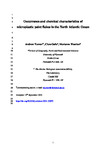Occurrence and chemical characteristics of microplastic paint flakes in the North Atlantic Ocean
| dc.contributor.author | Turner, Andrew | |
| dc.contributor.author | Ostle, C | |
| dc.contributor.author | Wootton, M | |
| dc.date.accessioned | 2021-10-21T12:56:52Z | |
| dc.date.issued | 2022-02-01 | |
| dc.identifier.issn | 0048-9697 | |
| dc.identifier.issn | 1879-1026 | |
| dc.identifier.other | 150375 | |
| dc.identifier.uri | http://hdl.handle.net/10026.1/18134 | |
| dc.description.abstract |
Non-fibrous microplastics sampled by the Continuous Plankton Recorder (CPR) Survey throughout the North Atlantic Ocean during 2018 have been recorded and a selection (n = 17, or 16.7%) physically and chemically characterised. The average abundance of non-fibrous particles captured by the plankton silks and detectable by microscopy was estimated to be around 0.01 m-3, with the highest concentrations evident in shelf seas of northwest Europe. Amongst the samples analysed, median size was 180 μm and, based on visible properties (e.g., brittleness, layering) and infra-red spectra, all but one were identified as flakes of paint. Semi-quantitative analysis by energy-dispersive X-ray fluorescence spectrometry with a collimated beam revealed that six flakes from European shelf seas were Cu-based antifouling formulations (without evidence of organo-Sn compounds), and five with a broader geographical distribution were Pb-based formulations of likely marine origin. Other elements regularly detected included Cr, Fe, Ti and Zn that were present in pigments or as contaminants from the underlying substrate. After fibres, paint flakes appear to be the most abundant type of microplastic in the oceans that, because of the abundance and mobility of metallic additives, deserve closer scientific attention. | |
| dc.format.extent | 150375-150375 | |
| dc.format.medium | Print-Electronic | |
| dc.language | en | |
| dc.language.iso | en | |
| dc.publisher | Elsevier BV | |
| dc.subject | Energy-dispersive XRF | |
| dc.subject | Paint flakes | |
| dc.subject | Microplastics | |
| dc.subject | Pigments | |
| dc.subject | Atlantic Ocean | |
| dc.subject | Metals | |
| dc.title | Occurrence and chemical characteristics of microplastic paint flakes in the North Atlantic Ocean | |
| dc.type | journal-article | |
| dc.type | Journal Article | |
| plymouth.author-url | https://www.webofscience.com/api/gateway?GWVersion=2&SrcApp=PARTNER_APP&SrcAuth=LinksAMR&KeyUT=WOS:000709141800005&DestLinkType=FullRecord&DestApp=ALL_WOS&UsrCustomerID=11bb513d99f797142bcfeffcc58ea008 | |
| plymouth.issue | Pt 1 | |
| plymouth.volume | 806 | |
| plymouth.publication-status | Published | |
| plymouth.journal | Science of The Total Environment | |
| dc.identifier.doi | 10.1016/j.scitotenv.2021.150375 | |
| plymouth.organisational-group | /Plymouth | |
| plymouth.organisational-group | /Plymouth/Faculty of Science and Engineering | |
| plymouth.organisational-group | /Plymouth/Faculty of Science and Engineering/School of Geography, Earth and Environmental Sciences | |
| plymouth.organisational-group | /Plymouth/REF 2021 Researchers by UoA | |
| plymouth.organisational-group | /Plymouth/REF 2021 Researchers by UoA/UoA07 Earth Systems and Environmental Sciences | |
| plymouth.organisational-group | /Plymouth/Research Groups | |
| plymouth.organisational-group | /Plymouth/Research Groups/BEACh | |
| plymouth.organisational-group | /Plymouth/Research Groups/Marine Institute | |
| plymouth.organisational-group | /Plymouth/Users by role | |
| plymouth.organisational-group | /Plymouth/Users by role/Academics | |
| dc.publisher.place | Netherlands | |
| dcterms.dateAccepted | 2021-09-12 | |
| dc.rights.embargodate | 2022-9-16 | |
| dc.identifier.eissn | 1879-1026 | |
| dc.rights.embargoperiod | Not known | |
| rioxxterms.versionofrecord | 10.1016/j.scitotenv.2021.150375 | |
| rioxxterms.licenseref.uri | http://www.rioxx.net/licenses/all-rights-reserved | |
| rioxxterms.licenseref.startdate | 2022-02-01 | |
| rioxxterms.type | Journal Article/Review | |
| plymouth.funder | Plankton science for supporting the implementation of marine ecosystem-based management and conservation::NERC |


